This post may contain affiliate links. Please read our disclosure policy.
Kung Pao Chicken is one of the top Chinese takeout dishes in America but did you know how easy it is to recreate this at home? The stir fried chicken and vegetables are lightly sauced in a sweet and savory glaze that has the signature flavors of Szechuan cuisine. It’s perfect with a bowl of rice for a weeknight dinner!

Watch the Kung Pao Chicken Recipe Video!
Table of Contents
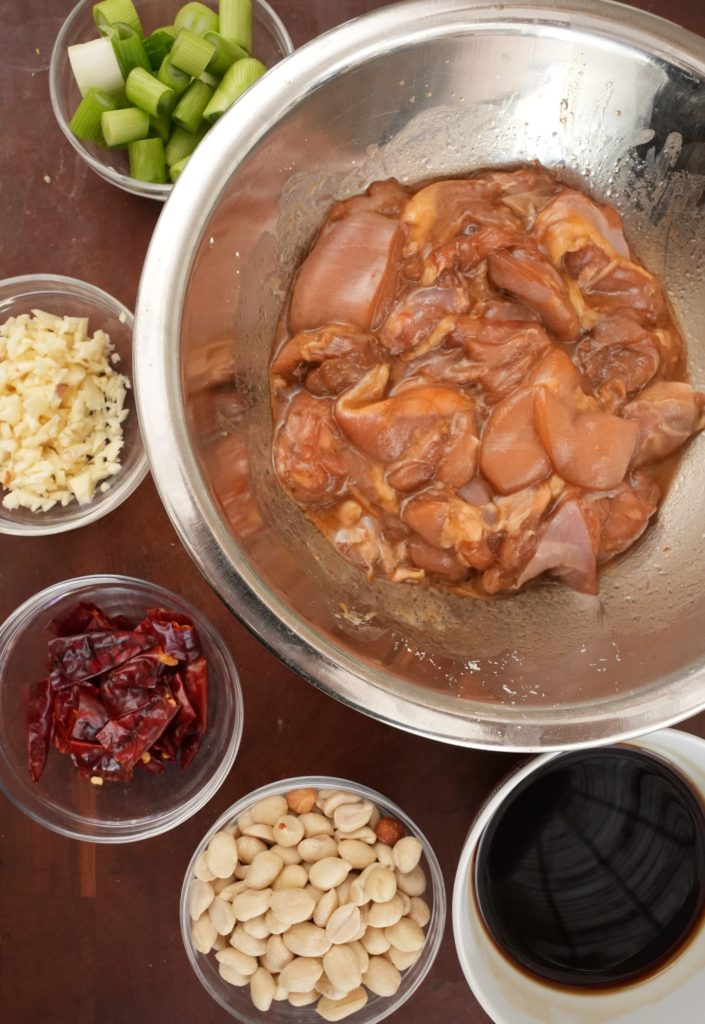
Ingredient Tips
Refer to the recipe card for the full list of ingredients and measurements!
- chicken: I like to use 1″ pieces of chicken thigh for Kung Pao Chicken. You want to cut them into similar sized pieces so the chicken can cook evenly. You can substitute with chicken breast if you prefer.
- light soy sauce vs dark soy sauce: You will need “light” (you can either use light or “low sodium” light soy sauce) or “all-purpose” soy sauce. Dark soy sauce is thicker, darker, and sweeter (as well as has a higher sodium content) than all-purpose soy sauce, which is why we use less of it. I don’t recommend using one as a substitute for the other.
- Shaoxing wine – This is one of my favorite Chinese pantry staples. It adds a depth of flavor and complexity to the sauce and truly one of my “secret ingredients” for making restaurant quality Chinese food. If you can’t find it, you can substitute with mirin, sherry, or even chicken broth.
- chicken stock – if you don’t have chicken stock on hand, you can substitute with water
- MSG: I like to use MSG in moderation as a flavor enhancer; you can always skip it!
- scallions: you can also use leeks
- ground sichuan peppercorns: I highly recommend grounding these by hand – I do it in my mortar and pestle. The flavor will be the freshest when ground by hand vs. buying them ground.
- dried red chilies – I can find these at most grocery stores – they’re labeled as “dried red chilis” or sometimes “japones chilis”. They’re not super spicy but if you are sensitive to heat, you can adjust by using less chilis OR by removing the seeds. The seeds don’t contain the chemical that make the peppers hot but they are oftentimes coated with oils that make peppers hot.
- neutral oil, for frying – My favorite neutral oil is avocado oil, but you can also use canola or vegetable oil! I don’t use olive oil when cooking Chinese food for two reasons: 1. It has a low burning point and 2. The flavor profile does not work with the flavors of Chinese cooking.
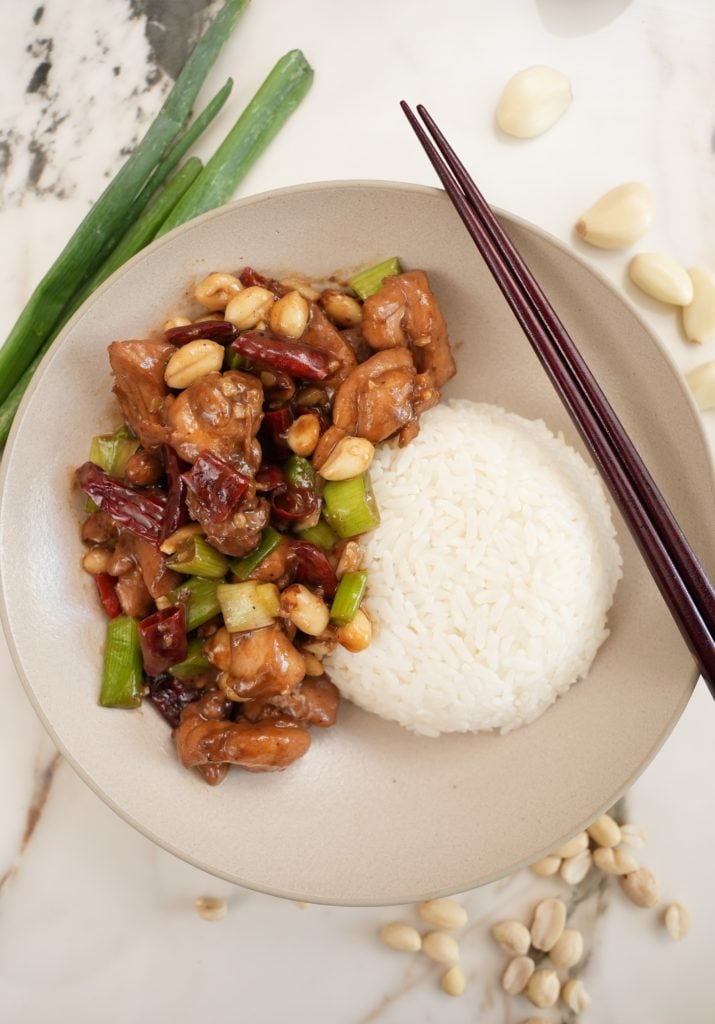
Recipe Instructions
1. Prep and Marinate The Chicken
Cut your chicken into 1″ pieces so they cook evenly. Place in a medium sized bowl.
Into the same bowl with the chicken, add your Kung Pao Chicken marinade ingredients (soy sauce, dark soy sauce, white pepper, salt, Shaoxing wine, neutral oil, and cornstarch). Mix well so each piece of chicken is coated evenly with the marinade. Once mixed, set aside for 20 minutes.
2. Mix The Kung Pao Sauce
I like to have my sauce premixed and ready to go before cooking the chicken. Combine your sauce ingredients (chicken broth or stock, soy sauce, dark soy sauce, rice vinegar, Shaoxing wine, sugar, cornstarch, and optional MSG) into a small bowl. Mix well so each ingredient is incorporated. Set aside.
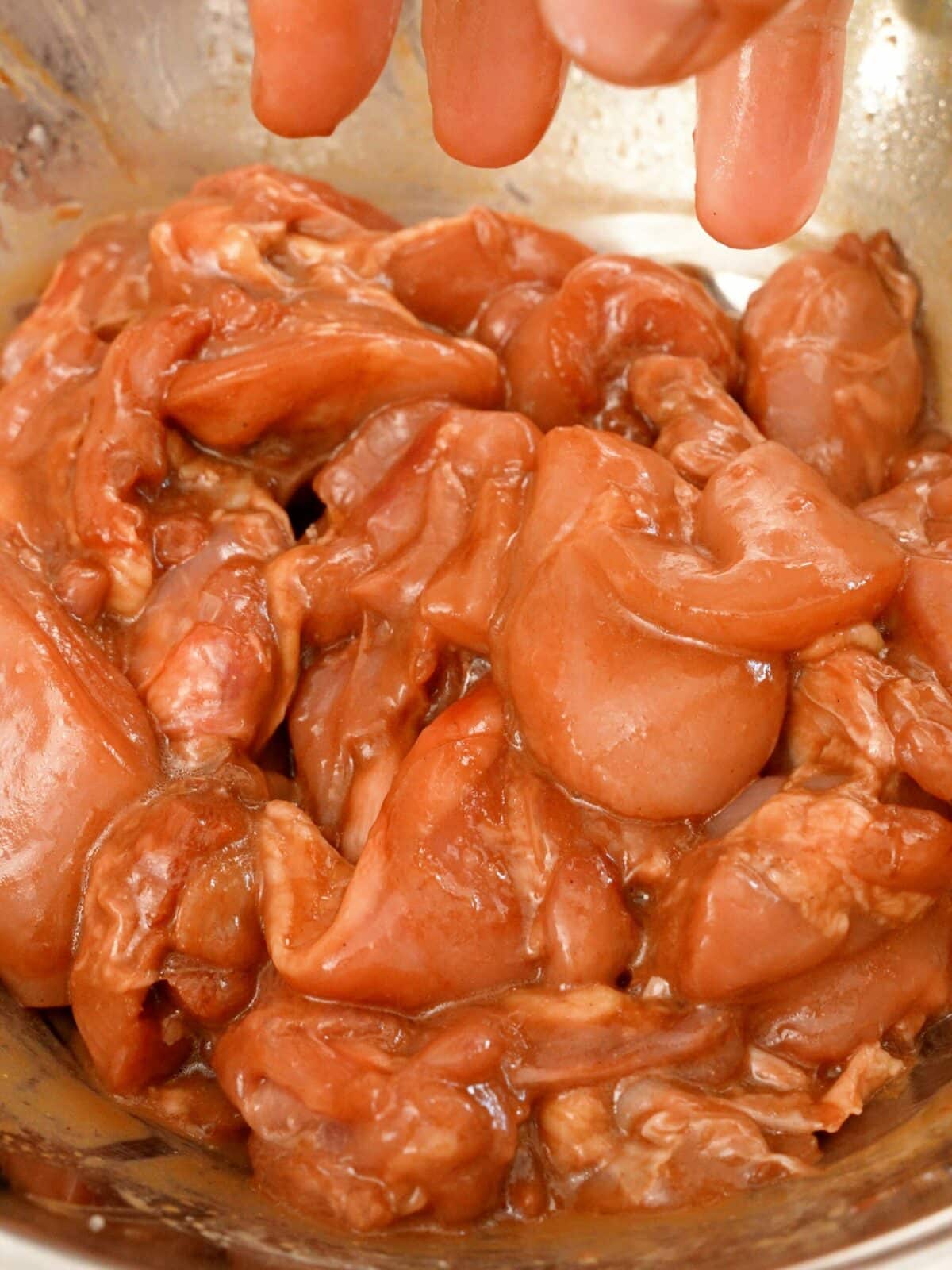
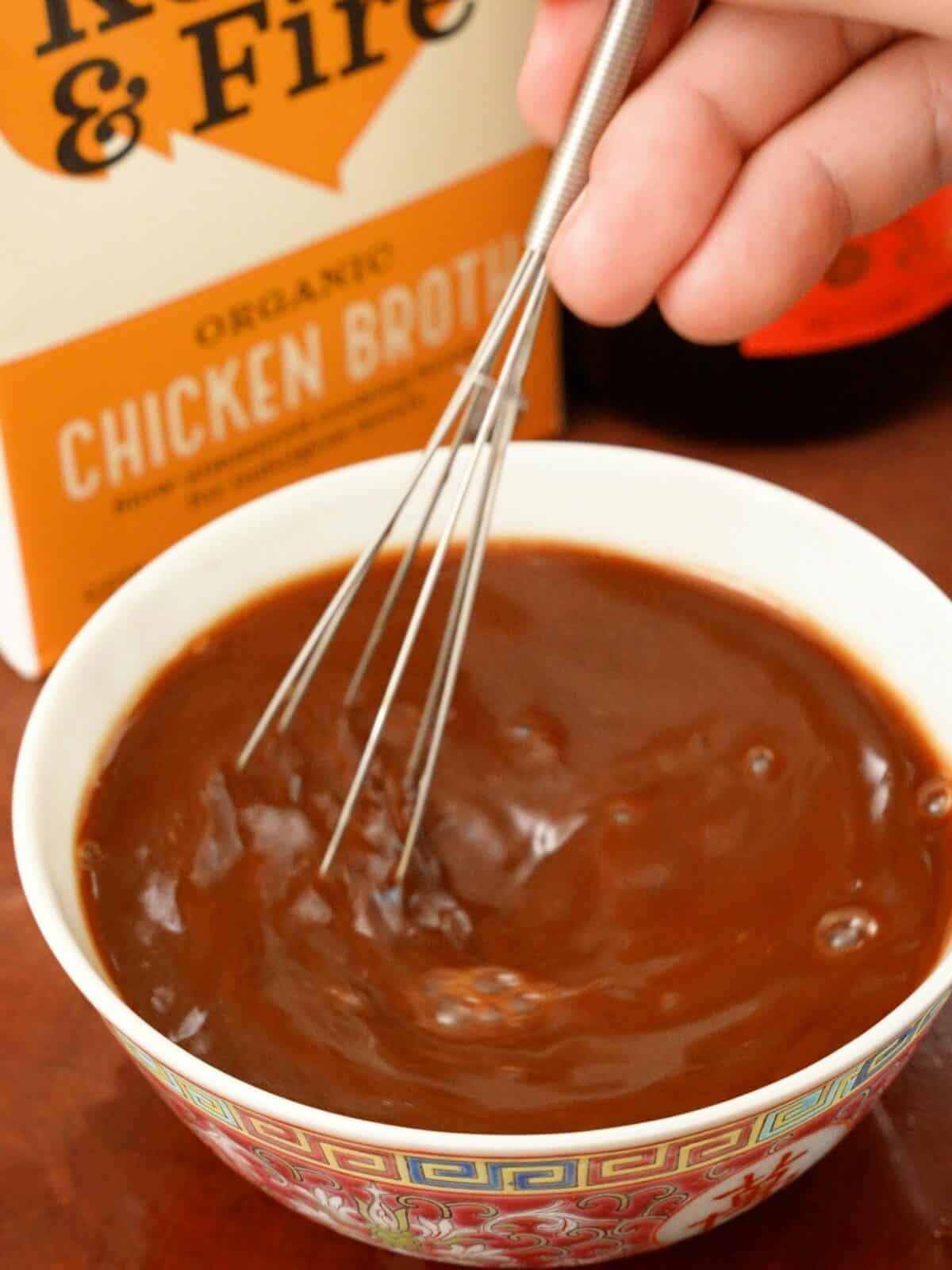
3. Fry The Peanuts
Heat up your wok or pan with 1 tablespoon of oil over medium high heat. Take your raw peanuts and fry for 1-2 minutes. You want these to look golden brown. Once the peanuts look done, remove from your wok or pan and set aside.
4. Cook the Chicken!
Take your wok or pan and pour 3 tablespoons of oil over high heat. Once you see the oil smoking, it’s time to cook your chicken.
Take your marinated chicken pieces and place in the wok or pan. Cook for 4-5 minutes until the chicken is fully cooked and browned. Remove the chicken and leave the excess oil to sauté the garlic and the remainder of the aromatics.
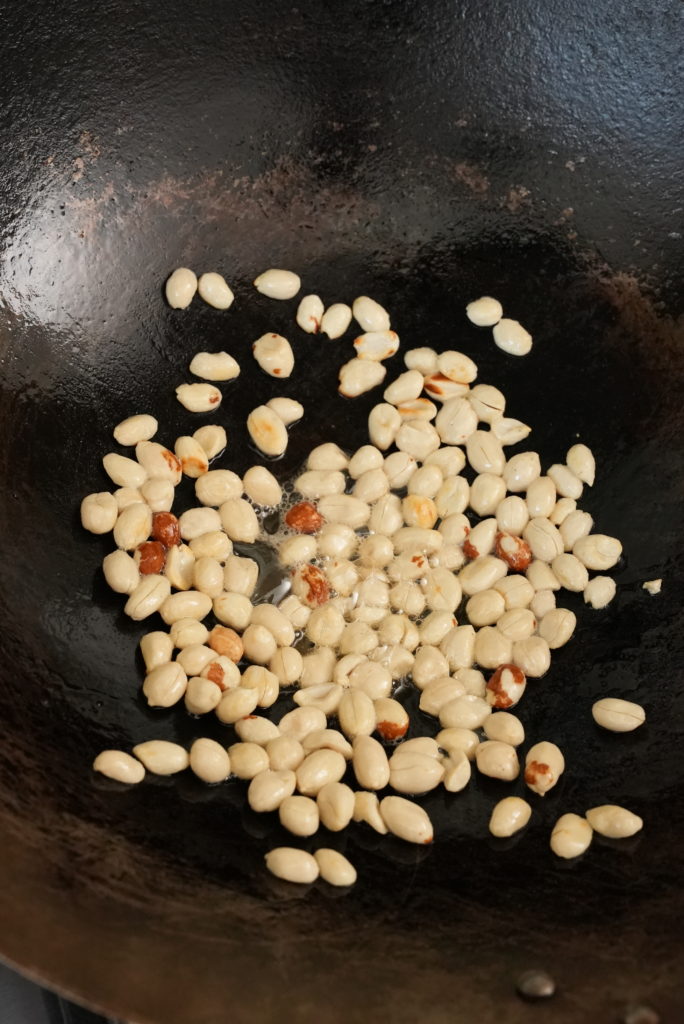
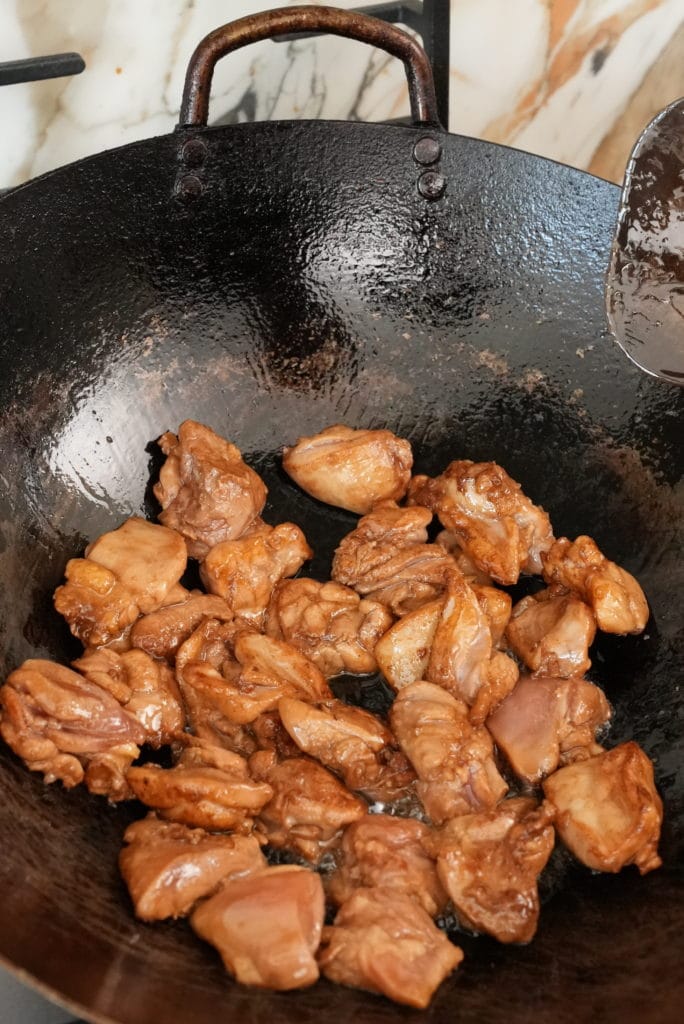
5. Add the Kung Pao Sauce and Finish the Dish!
Bring your heat down to medium-high heat and place your garlic, red chilis, and ground Sichuan peppercorns in your wok or pan. Cook for 5-10 seconds until fragrant.
(This part is going to go fast!) Add back the chicken into the wok or pan with the aromatics. Pour the sauce over the chicken and work quickly to mix and evenly coat all of the chicken. Once the chicken looks coated, add the peanuts. Stir and then add the scallions. Continue cooking for another 1-2 minutes until the sauce has thickened to your liking. Once ready, serve your Kung Pao Chicken with a side of rice.

PRO TIPS
Expert Tips + Storage
Kung Pao Chicken is one of those dishes that comes together FAST once you start cooking. For this reason, it’s crucial that you prepare your ingredients (chicken and vegetables cut and portions, sauce mixed, etc) BEFORE you begin cooking. I like to have all of my ingredients in individual bowls, near my cook station so I can easily grab when needed.
This dish has a numbing spice that are caused by the chilis and peppercorns. If you are sensitive to spice, you may want to adjust:
- dried red chilis – these are not super spicy; however, if you want to reduce the heat, you can either use less chilis or remove the seeds from inside. The seeds are oftentimes coated in an oil that makes them spicy (the seeds themselves are not spicy).
- Szechuan peppercorns – you will be grinding these for the recipe (I always prefer grinding them myself for freshness, but you can use pre-ground Szechuan peppercorn as well; if you are sensitive to the mouth numbing feel of Szechuan peppercorns, you can always reduce the amount used in Kung Pao Chicken! The other flavors of the dish will still taste great.
Cooking with a Wok – If it is your first time cooking with a wok, make sure to read my “How To Season a Wok” post. There is a video included that shows exactly how to season your brand new wok and how to maintain it so it lasts for years. If you cannot or do not want to use a wok to make Kung Pao Chicken, you can use a large pan, cast iron, or even a dutch oven.
Storage – You can store Kung Pao Chicken in the refrigerator in an airtight container for up to 3 days. Because the chicken is not coated in a batter (similar to Beef and Broccoli, String Bean Chicken, Mushroom Chicken or Cashew Chicken) you won’t have to worry about trying to restore the crispy texture of the dish – I recommend reheating this in the microwave or in a hot pan/wok for a couple minutes (add a little bit of water if you want to loosen up the chicken pieces that stuck together in the refrigerator).
What to Serve with Kung Pao Chicken
Recreate your favorite Chinese Take-Out meal with Egg Rolls and Egg Drop Soup (or Chicken Corn Egg Drop Soup, if you want a heartier version) or Hot and Sour Soup! Enjoy Chicken Fried Rice (if you want shrimp instead, try Shrimp Fried Rice)and Shrimp Lo Mein (if you need a chicken option, try Chicken Lo Mein)! If you’re nostalgic for mall food, make sure to include my Panda Express Chow Mein! For another chicken dish, make General Tso’s Chicken or the sadly discontinued Panda Express Sweetfire Chicken Breast!
If you tried this Kung Pao Chicken or any other recipe on my website, please leave a 🌟 star rating and let me know how it went in the comments below!
Kung Pao Chicken

Equipment
Ingredients
Chicken
- 1 lb chicken thigh, cut into 1" pieces
- 1 tsp dark soy sauce
- 1 tbsp light soy sauce
- 1/4 tsp white pepper
- 1/2 tsp kosher salt
- 1 tbsp shaoxing wine
- 1 tbsp cornstarch
- 1 tbsp neutral oil
Sauce
- 1 tbsp light soy sauce
- 1 tbsp rice vinegar
- 1 tsp dark soy sauce
- 1 tbsp shaoxing wine
- 1/4 tsp msg, optional
- 1 tbsp sugar
- 1/2 cup chicken stock, high quality
- 1/2 tbsp cornstarch
Vegetables & Oil
- 3 tbsp neutral oil, I used avocado oil
- 6 scallion whites, cut into 1/2" pieces
- 4 dried red chilis, cut into 1/2" pieces
- 1 tsp szechuan peppercorn, ground
- 5 cloves garlic, minced
- 1/3 cup unsalted peanuts
Instructions
- Marinate chicken in with light soy sauce, dark soy sauce, white pepper, kosher salt, shaoxing wine, neutral oil and cornstarch for 20 minutes.
- Mix sauce in a bowl by combining light soy sauce, dark soy sauce, rice vinegar, sugar, msg, high quality chicken stock and cornstarch.
- In a wok or pan, fry peanuts in 1 tbsp oil over medium heat for 2 minutes, remove and cool.
- Over high heat, add 3 tbsp neutral oil to a pan and add chicken. Cook until cooked through and set aside (about 4-5 minutes).
- In the remaining oil over medium high heat, fry red chilis and szechuan peppercorn powder for 15 seconds, then add garlic for another 15 seconds. Add back chicken and sauce. Cook for another minute until the chicken is cooked through and the sauce has thickened slightly.
- Add peanuts and scallion whites and cook for another 30 seconds to combine. Serve with rice and enjoy!
Notes
- dried red chilis – these are not super spicy; however, if you want to reduce the heat, you can either use less chilis or remove the seeds from inside. The seeds are oftentimes coated in an oil that makes them spicy (the seeds themselves are not spicy).
- Szechuan peppercorns – you will be grinding these for the recipe (I always prefer grinding them myself for freshness, but you can use pre-ground Szechuan peppercorn as well; if you are sensitive to the mouth numbing feel of Szechuan peppercorns, you can always reduce the amount used in Kung Pao Chicken! The other flavors of the dish will still taste great.
Nutrition
Nutrition information is automatically calculated, so should only be used as an approximation.


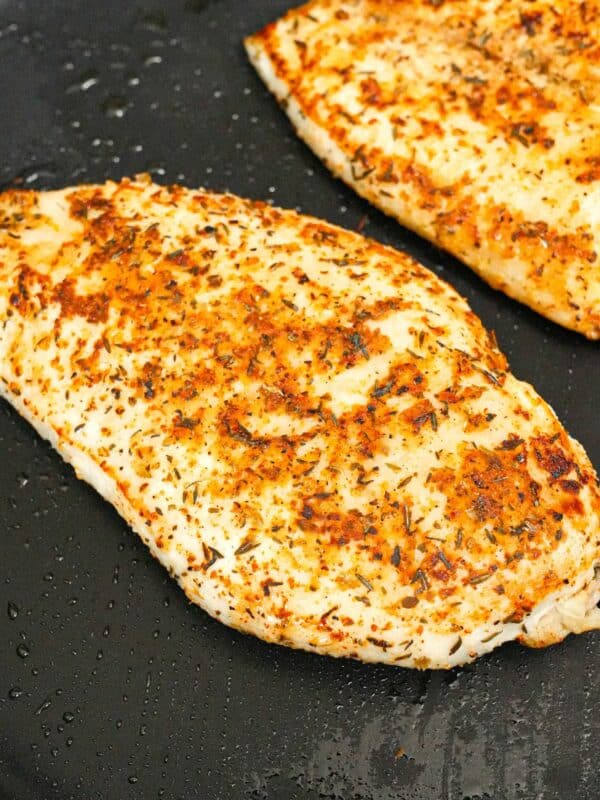

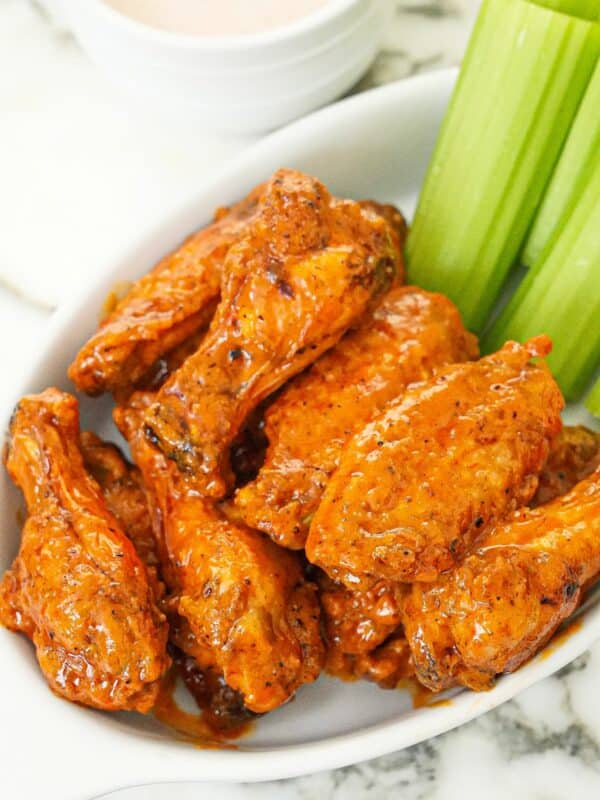







I’m trying to gather ingredients and I’m confused about the soy sauce. I only have the AP soy sauce at home and did not find light and dark at the grocery store so k figured I would look online. But your link to the light soy sauce is for low sodium. I’m confused since you wrote not to use low sodium or did I read it wrong?
Hi Lili – I’ve clarified this in the ingredient section. Sorry for the confusion! There are two types of soy sauce – Regular soy sauce (sometimes called “light”) and Dark soy sauce. In the category of regular soy sauce, there are low sodium versions of it. I hope that helps!
Tried it today , all liked it , I used a pepper cut in pcs. also, I also couldn’t find dried peppers but a Thai resturant gave me dried ground peppers they use and it was ok, just need more of them ! They have very good Kung Pao Chicken ,they also use water chestnuts & Bamboo strips in theirs , very good ,thanks will try other receipes .
Thanks Jerry!
Made this with a wok and it was amazing! The family loved it-it had the perfect flavor! Better than takeout.
IG: pastor.danielseo
Made this with a wok and it was amazing! The family loved it-it had the perfect flavor! Better than takeout.
Quick and easy and better than takeout!
I just love your recipes, especially because we have the ingredients at home!
Kung Pao chicken is one of my fav Chinese takeout sides so this definitely hit the spot for me!!